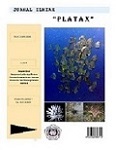Zooplankton Community In Coastal Malalayang Waters Manado
DOI:
https://doi.org/10.35800/jip.5.1.2017.15808Abstract
The purpose of this study was to identify the zooplankton, to know the relative density of zooplankton, and to analyze their community structure, such as Diversity Index (H') and Dominance Index (C).
Sampling was conducted on September 30th, 2016 at the depth of 50 cm-withdrawn slowly along 40 meter (2x20 meter back and forth) in each station. The water left in the cod end (reservoir bottle) put into a sample bottle, with alcohol 95%, and taken to the laboratory for identification.
Based on the identification, there were 25 species of zooplankton (19 adults, one final larval stage brachyura, 4 larvae of mollusks and worms, and 1 fish larvae 1 unidentified), namely: Oncaea sp. [1], Oncaea sp. [2], Oncaea sp. [3], Diastylis sp., Monstrilla sp., Euchaetomera sp., Euchaeta sp., Ibacus sp., Oithona sp., Synchaeta sp., Farranula sp., Macrosetella sp., Eurydice sp., Calanus sp., Lucifer sp., Eucalanus sp., Scolecithricella sp., Lucicutia sp., Lepidasthenia sp., megalops brachyura, zoea brachyura, larvae of eulimella, larvae of echinospira, larvae of corethra and larvae of fish. Relative density was the highest in Oncaea sp. (34.21%) and Diversity Index (H') was classified as moderate. The diversity index showed that the zooplankton community was less diverse. Dominance Index (C) was also low indicating no species was dominant in the coastal waters of Malalayang.
Keyword : Community, zooplankton, Malalayang Dua
Abstrak
Â
Tujuan penelitian ini adalah untuk mengetahui jenis–jenis zooplankton, mengetahui kepadatan relatif zooplankton, dan menganalisa struktur komunitas zooplankton seperti Indeks Keanekaragaman (H’) dan Indeks Dominasi (C).
Pengambilan sampel dilakukan pada 30 September 2016 dengan cara memasukkan plankton net sedalam 50 cm, kemudian ditarik sambil berjalan secara perlahan sepanjang 40 meter (2x20 meter bolak-balik) di tiap stasiun. Air yang tersaring dalam cod end (botol penampungan) dituangkan di dalam botol sampel dan ditambahkan/diawetkan dengan alkohol 95%. Selanjutnya, sampel tersebut dibawa ke Laboratorium untuk diidentifikasi.
Berdasarkan hasil identifikasi diperoleh 25 jenis zooplankton (19 dewasa, 1 organisme muda [tahap akhir larva] zooplankton, 4 larva zooplankton dan 1 larva ikan yang tidak teridentifikasi) yaitu: Oncaea sp. [1], Oncaea sp.[2], Oncaea sp.[3], Diastylis sp., Monstrilla sp., Euchaetomera sp., Euchaeta sp., Ibacus sp., Oithona sp., Synchaeta sp., Farranula sp., Macrosetella sp., Eurydice sp., Calanus sp., Lucifer sp., Eucalanus sp., Scolecithricella sp., Lucicutia sp., Lepidasthenia sp., Megalopa Brachyura, Zoea Brachyura, Larva Eulimella, Larva Echinospira, Larva Corethra dan Larva Ikan. Kepadatan Relatif tertinggi terdapat pada Oncaea sp. sebesar 34,21% Nilai Indeks Keanekaragaman (H’) zooplankton di tiga Stasiun tergolong sedang. Nilai tersebut menunjukkan bahwa komunitas organisme dalam kondisi yang kurang beragam. Hasil Indeks Dominasi (C) termasuk kriteria dominasi rendah, menunjukkan bahwa tidak ada spesies yang mendominasi di perairan pantai Malalayang.
Kata kunci : Komunitas, zooplankton, Malalayang Dua
Downloads
Published
How to Cite
Issue
Section
License
COPYRIGHT
Authors who publish with this journal agree to the following terms:
Authors hold their copyright and grant this journal the privilege of first publication, with the work simultaneously licensed under a Creative Commons Attribution License that permits others to impart the work with an acknowledgment of the work's origin and initial publication by this journal.
Authors can enter into separate or additional contractual arrangements for the non-exclusive distribution of the journal's published version of the work (for example, post it to an institutional repository or publish it in a book), with an acknowledgment of its underlying publication in this journal.
Authors are permitted and encouraged to post their work online (for example, in institutional repositories or on their website) as it can lead to productive exchanges, as well as earlier and greater citation of the published work (See The Effect of Open Access).




















